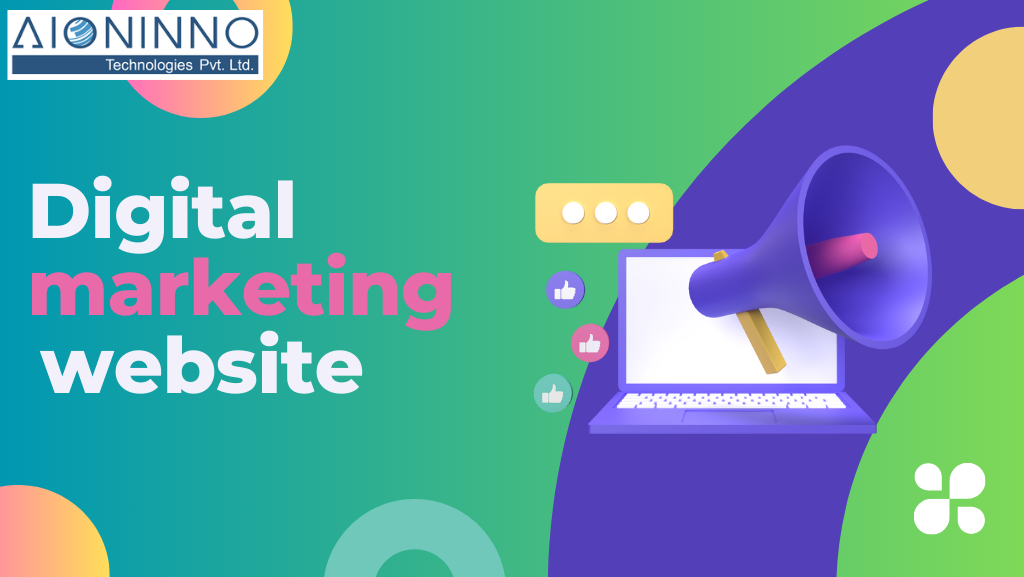digital marketing website
In this digital age, having a strong online presence is crucial for businesses of all sizes. To thrive in the competitive digital landscape, companies need to invest in effective digital marketing strategies. That’s where AIONINNO Technologies Pvt. Ltd. comes in. As a leading digital marketing website, they offer a range of innovative solutions to help businesses boost their online visibility, drive traffic, and generate leads. In this blog post, we will explore the various services and expertise provided by AIONINNO Technologies Pvt. Ltd., and how their digital marketing solutions can revolutionize your business’s online success.
Introduction to AIONINNO Technologies Pvt. Ltd. and its expertise in digital marketing
In today’s digital age, businesses cannot afford to overlook the importance of a strong online presence. With the ever-evolving landscape of digital marketing, companies need to stay ahead of the game to remain competitive. This is where AIONINNO Technologies Pvt. Ltd. comes in. AIONINNO Technologies Pvt. Ltd. is a leading digital marketing agency that specializes in helping businesses establish and enhance their online presence. With a team of skilled professionals, AIONINNO Technologies offers a wide range of digital marketing services tailored to meet the unique needs of each client.
From search engine optimization (SEO) and pay-per-click (PPC) advertising to social media marketing and content creation, AIONINNO Technologies has the expertise to create effective strategies that drive results. Their comprehensive approach ensures that businesses are not only visible online but also engage with their target audience, generate leads, and ultimately increase conversions. What sets AIONINNO Technologies apart is their commitment to staying on top of the latest digital marketing trends and technologies.
The importance of having a professional website for digital marketing.
In today’s digital age, it is essential for businesses to have a strong online presence to stay competitive. One of the key components of a successful digital marketing strategy is having a professional website. Your website serves as the face of your business in the digital world, acting as a virtual storefront that is accessible 24/7. Having a professional website is crucial for several reasons. First and foremost, it allows you to make a great first impression on potential customers. When people search for products or services online, they expect to find a legitimate business with a well-designed and user-friendly website.
By having a well-maintained website, you demonstrate that you are a legitimate and trustworthy business. This helps to alleviate any doubts or concerns that potential customers may have and encourages them to engage with your brand. Additionally, a website is a powerful tool for digital marketing. It serves as a central hub for all your online marketing efforts, allowing you to showcase your products or services, provide valuable content, and capture leads. With a professional website, you can optimize it for search engines, implement effective call-to-action buttons, and integrate social media accounts, thereby amplifying your digital marketing efforts and driving more traffic to your website.
Key elements to consider when designing a digital marketing website
When designing a digital marketing website, there are several key elements that you need to consider in order to create a successful and engaging online presence for your brand. These elements will not only help you attract visitors, but also convert them into loyal customers. First and foremost, your website should be responsive. With the increasing use of mobile devices, it is crucial that your website is mobile-friendly and adapts seamlessly to different screen sizes. This ensures that users have a positive browsing experience, regardless of the device they are using. A responsive website not only improves user engagement but also boosts your search engine rankings. Next, focus on creating engaging and compelling content. Your website should showcase your expertise and provide valuable information to your target audience. Use a combination of well-written copy, visually appealing images, and interactive elements to keep visitors engaged and encourage them to explore further.
Optimizing your website for search engines and user experience
Optimizing your website for search engines and user experience is crucial to ensure maximum visibility and engagement. Implementing UI/UX web design practices is the first step towards creating a visually appealing and user-friendly website that grabs attention and keeps visitors engaged. This involves designing intuitive navigation, using clear and concise content, and incorporating visually appealing elements such as images, videos, and interactive features. In addition to UI/UX design, content marketing plays a vital role in optimizing your website. By providing valuable, relevant, and well-structured content, you not only attract and retain visitors but also establish your website as an authority in your industry.
By doing so, search engines can easily identify and rank your website for relevant search queries, increasing your visibility and driving organic traffic. It’s equally important to fix any technical SEO issues that may hinder search engine crawlers from properly indexing and understanding your website. This involves ensuring proper website structure, optimizing website speed and performance, and resolving any broken links or duplicate content issues. Speaking of speed, optimizing your website’s loading time is crucial for both search engine rankings and user experience. Slow-loading websites tend to have higher bounce rates and lower conversion rates. By compressing images, minifying code, and leveraging caching techniques, you can significantly improve your website’s speed and provide a seamless browsing experience.
Incorporating effective content marketing strategies into your website
Incorporating effective content marketing strategies into your website is crucial for driving traffic, generating leads, and ultimately achieving success for your business. AIONINNO Technologies Pvt. Ltd. understands the importance of utilizing content marketing to its fullest potential, and we are here to guide you through the process. The first step in implementing an effective content marketing strategy is to define your goals. What are you looking to achieve with your website? Do you want to increase brand awareness, generate leads, or establish thought leadership in your industry? Clearly defining your goals will help you shape your content and ensure that it aligns with your overall marketing strategy. Once you have defined your goals, it’s essential to identify your unique value proposition and messaging. What sets your business apart from your competitors?
What value do you bring to your target audience? Understanding your unique selling points will help you create content that resonates with your audience and showcases the value you provide. Next, it’s time to develop a content plan that aligns with your goals and messaging. This involves creating a content calendar, brainstorming topic ideas, and outlining the types of content you want to produce, such as blog posts, videos, infographics, or case studies. Your content plan should prioritize quality and consistency, ensuring that you are regularly publishing relevant and valuable content for your audience. In addition to creating great content, it’s crucial to choose the proper channels to distribute your content. This could include your website’s blog, social media platforms, email newsletters, or industry publications.
Utilizing social media integration and engagement on your website
In today’s digital age, social media has become an integral part of our lives. It offers a tremendous opportunity for businesses to connect with their audience and promote their brand. To fully leverage the power of social media, it is crucial to integrate it into your website effectively. By doing so, you can enhance engagement, increase brand visibility, and drive traffic to your website. One of the first steps in utilizing social media integration is to add social sharing links to your blog posts. This allows your readers to easily share your content with their own social networks, expanding your reach and potentially attracting new visitors to your website. By placing prominent social sharing buttons at the end of each blog post, you encourage readers to share your valuable content with just a click of a button. Additionally, consider adding social posts directly to your website.
Another effective way to integrate social media is by offering a social login option on your website. This allows users to sign in or register using their social media accounts, eliminating the need for them to create new login credentials. Social login not only simplifies the user experience but also provides you with valuable user data and insights. To further enhance your website’s social integration, consider adding social sharing links to your footer. This ensures that your social media profiles are easily accessible from any page on your website, allowing visitors to connect and engage with your brand effortlessly.
Measuring and analyzing website performance using analytics tools
Measuring and analyzing website performance is crucial for businesses to understand their online presence and make informed decisions. With the help of analytics tools, you can gather valuable insights into various aspects of your website’s performance. Here are some key metrics to consider: 1. Page views: This metric indicates the total number of times your website pages have been viewed. It gives you an overall idea of your website’s traffic and popularity. 2. Unique visitors: Unlike page views, unique visitors represent the number of individual users who have visited your website. This metric helps you understand the size of your audience and measure the effectiveness of your marketing efforts in attracting new visitors. 3. Engagement: Engagement metrics provide insights into how users interact with your website.
Metrics such as time spent on page, scroll depth, and click-through rates indicate the level of user engagement and can help you optimize your content and design for better user experience. 4. Bounce rate: Bounce rate represents the percentage of visitors who leave your website after viewing just one page. A high bounce rate may indicate that visitors are not finding what they are looking for or that your website needs improvement in terms of navigation or content relevance. 5. Top pages and exit pages: Analyzing the most visited pages on your website and the pages from which users frequently exit can provide valuable information about popular content and potential areas for improvement or optimization. 6. Referrals: Referral metrics track the sources from which visitors arrive at your website, such as search engines, social media platforms, or other websites




